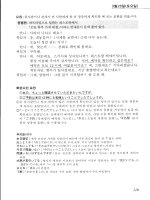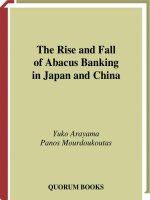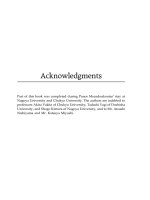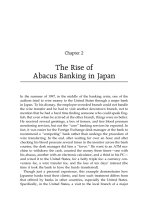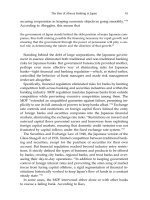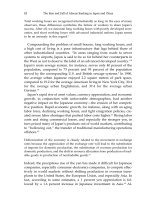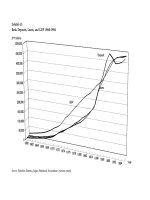The Rise and Fall of Abacus Banking in Japan and China phần 9 doc
Bạn đang xem bản rút gọn của tài liệu. Xem và tải ngay bản đầy đủ của tài liệu tại đây (361.54 KB, 19 trang )
The Fall of Abacus Banking in China 135
employed rural migrant workers are added, China’s official unemploy-
ment rate of 3 percent jumps to close to 10 percent.
11
In fact, China’s
unemployment rate increased from 3.3 percent in 1993 to 8 percent in
1998.
12
As expected, price destruction took its toll on one of the country’s
exports, especially after the Asian crisis. In 1998, for instance, China’s
exports fell to around 7 percent, one-third of the previous year’s growth.
Compounding the problem of slower export growth, the Asian crisis
scared away foreign investors, making it difficult for its allying SOEs to
raise capital through initial public offerings. By 1997, direct foreign in-
vestment had fallen to half of its 1995 size, while exports slowed down
(see Exhibits 6.4 and 6.5).
With both exports and foreign investment slowing down, China’s ec-
onomic growth came down to earth. Indeed, economic growth declined
from its 14 percent peak in 1993 to around 8 percent in 1999 (see Exhibit
6.6).
In short, China’s lack of an expanding international and domestic fron-
tier and her inability to innovate have taken their toll on her economy,
most notably on her SOEs, which have been faced with declining prof-
itability. Indeed, SOE profits declined from RMB80 billion in 1994 to
RMB20 billion in 1998 (see Exhibit 6.7). With declining profits, SOEs con-
tinued to rely on state banks, both for short-term (working) capital and
medium-term capital. Indeed, in 1997, close to 90 percent of state bank
capital was allocated to finance the capital needs of SOEs (see Exhibit
6.8). Reflecting the heavy SOE borrowing from banks, the debt-to-equity
ratio of some SOEs has exceeded 500. In practice, such a heavy debt
burden means ‘‘that many of China’s state-owned firms are insolvent—
some cannot even cover their operating costs with their income.’’
13
Worse, such loans were made at below deposit rates, turning the in-
terest rate spread negative. Indeed, from April 1990 to January 1995, the
gap between the average deposit rates and lending rates for ten-year
loans ranged between Ϫ0.36 and Ϫ4.32 percentage points.
14
The Chinese government sets many interest rates according to industrial or
broader policy objectives rather than according to commercial ones, and the com-
mercial banks are still obliged to carry the loans at the dictated rates. Moreover,
the commercial banks’ biggest burden is unrecoverable working capital loans to
defray public enterprise losses.
15
In addition, the country’s economic slowdown has taken its toll on the
central and provincial governments, which also turned to banks to fi-
Exhibit 6.4
Foreign Direct Investment in China (1995–1997)
Source: State Statistical Bureau (various years).
The Fall of Abacus Banking in China 137
Exhibit 6.5
China’s Trade (1992–1997)
Source: State Statistical Bureau (various years).
nance their spending, an issue that will be further addressed in the next
chapter.
Reflecting the increasing reliance of both SOEs and government on
bank financing, when the economy slowed down, M2, a broad measure
of money supply took off (see Exhibit 6.9). Such monetary expansion in
turn fueled China’s own economic bubble—Securities markets, both in
Shanghai and in Hong Kong, soared. Between 1994 and 1997, for in-
stance, the number of listed companies in the Shanghai and Shenzhen
increased from 291 to 745, daily volume trade increased from $400 mil-
lion to $1.65 billion; and market capitalization increased from $42.2 bil-
lion $211.2 billion.
16
Real estate prices also rose in Hong Kong, both
before and after the Chinese takeover. In fact, a land auction that took
place at the end of August 1997, less than two months after Hong Kong
Exhibit 6.6
Real GDP Growth (1994–1999)
Source: State Statistical Bureau (various years).
Exhibit 6.7
SOE Profits (1994–1998)
Source: ‘‘China at a Loss: Giant on the Way to Reform,’’ Nihon Keizai Shimbun, April 30, 1999. Reprinted with per-
mission.
140 The Rise and Fall of Abacus Banking in Japan and China
Exhibit 6.8
Credit Funds Balance Sheet of State Bank User Funds in 1997
Source: State Statistical Bureau (various years).
was returned to China, yielded sharply higher prices. And as Japanese
investors did in the 1980s with art paintings, Chinese investors are now
snapping up antiques—one of the few assets that they are allowed to
own—while their government is investing the country’s trade surplus in
U.S. government bonds rather than in its own economy.
17
In addition, price destruction and the opening of the Chinese economy
to world markets have created an entirely new world for banks, an un-
certain environment manifested in the clash between central planners
and market forces. Under central planning, supply created its own de-
Exhibit 6.9
Money Supply of China (1977–1995)
Source: International Monetary Fund.
142 The Rise and Fall of Abacus Banking in Japan and China
mand, which in an attempt to keep the cost of living low was rationed
at below market price, perhaps explaining the frequent shortages of com-
modities in China and other central planning countries. But as central
planners eased their grip on the economy, as demand took precedence
over supply, it became increasingly difficult for central planners to pre-
dict demand, which could explain the surplus created in a number of
industries, with real estate being a case in point. According to the Hous-
ing Reform,
The middle class would buy the homes they rented from the government and
so create a spending boom, with banks issuing mortgages and new homeowners
refurbishing their flats. But the middle class hesitated to spend their savings on
apartments they had been renting cheap, and the banks shied at the risk of
lending to buyers. The expected housing market never materialized.
18
This can explain the real estate glut and the growing apartment va-
cancies in China’s Southeast regions, an issue that will be further ad-
dressed in the next chapter.
In short, by the mid-1990s, China’s economy, which for almost two
decades had been growing by leaps and bounds, was coming to a stand-
still and her industries and corporations began to taste the other side of
globalization—increasing competition, price swings, and the increasing
risk and uncertainty associated with them. For the first time, Chinese
managers had to learn how to compete in a global economy, especially
bank managers, who continued to lack the freedom, the incentive, and
the expertise to manage risk. Yet they continued to lend to their corpo-
rate clients (SOEs) as though nothing had changed, piling up non-
performing loans.
In this sense, China’s success in saving herself from the Asian conta-
gion reflects more the low degree of integration of the Chinese economy
to the global economy and less the subtle, intelligent Beijing policies.
Further, this means that unlike other Asian countries, a full-blown bank-
ing crisis is ahead rather than behind the Chinese economy, which will
be addressed in the next chapter.
NOTES
1. Quoted in The Economist, April 17, 1999.
2. See Arayama and Mourdoukoutas (1999), ch. 1.
3. Yang and Zhong (1998), p. 3.
The Fall of Abacus Banking in China 143
4. Sato (1998), p. 374.
5. I. Johnson and T. Ewing, ‘‘China Is a Big Swing in Commodity Markets,’’
Wall Street Journal, November 23, 1998, p. A18.
6. Arayama and Mourdoukoutas (1999), p. 32.
7. Ibid.
8. Smith (1994), p. R4.
9. I. Johnson, ‘‘China, With Economy Slowing, Renews Its Push to Join
WTO,’’ Wall Street Journal, June 4, 1999, p. A6.
10. D. Roberts, J. Barnathan, J. More, and S. Prasso, ‘‘China: What’s Going
Wrong?’’ Business Week, February 22, 1999.
11. Asian Development Report (1987), p. 49.
12. Saywell and Jiangsu (1999), p. 47.
13. Lardy (1996), p. 81.
14. Fry (1998), p. 96.
15. Brean (1998), p. 9.
16. Leggett (1998), p. R10.
17. Smith (1994).
18. Roberts et al., ‘‘China: What’s Going Wrong?’’ p. 49.
Chapter 7
The Looming
Banking Crisis in China
As in Japan, the only big spender in China is the Government, which
is pouring money into concrete, bricks and mortar for bridges, dams
and other projects, even if they crumble thanks to hasty construction
or corruption.
—Sheryl WuDunn
1
The Chinese now see clearly that a domestic banking sector plagued
with bad loans is a time bomb. An initial currency crisis, like a rapid
depreciation of the exchange rate, can quickly become a pervasive
domestic financial crisis, ruining both commercial and investment
banks.
—Shang-Jin Wei and Richard J. Zeckhauser
2
In most market economies when borrowers cannot meet their debt ob-
ligations for two consecutive months lenders call in the loans and even-
tually force the borrower to foreclose and liquidate the assets placed on
collateral for the loan. And in most market economies, government reg-
ulators monitor closely the financial performance of thrifts, especially
their reserves, shutting down the insolvent ones. In most market econ-
omies, banks screen prospective clients and set lending rates according
to their ability to repay loans.
As a rule this is not the case in China, however, especially since 1995,
146 The Rise and Fall of Abacus Banking in Japan and China
when price destruction and slower economic growth worsened the eco-
nomic conditions of SOEs. In an effort to keep SOEs afloat and preserve
employment for millions, Chinese bureaucrats have been overtaken by
growth hysteria, turning to infrastructure projects to make up for the
slowdown in export growth and the shortfall in foreign investments.
With eroding tax revenues, government bureaucrats have found mone-
tary policy and banking credit in particular the sole vehicle of financing
such projects. In fact, government bureaucrats have been ordering state
banks to expand their credit to already-bankrupt SOEs by Western stan-
dards, precipitating rather than ending the banking crisis.
Arguing this proposition, this chapter takes a close look at the size of
China’s banking crisis and extends the discussion of the previous chap-
ters to identify and elaborate on the factors that are fueling such a cri-
sis—namely, the failure of banks to apply the principles of financial
management, the slowdown in economic growth, the lack of a sound
taxation system, excess liquidity, the lack of a sound fiscal system, the
establishment of ITICs, an asset bubble, and the rapid deterioration of
the situation of SOEs.
On February 17, 1999, Beijing shut down one of the best-known City
International Trading Corporations (CITCs), the Guangdong Interna-
tional Trust Corporation (GITC). On June 23 of the same year, the ex-
ecutive vice governor of POB authorized the injection of 30 billion yuan
to Guangdong Enterprises, the province investment subsidiary in Hong
Kong.
3
On June 21, 1998, the Beijing government ordered the closure of
the Hainan Development Bank, the first bank to fail since communist
rule went into effect in 1949.
Though three isolated examples do not constitute sufficient evidence
for a full-blown banking crisis in China, they point to a looming banking
crisis as well as a number of foreign credit reports on the country’s major
banks. In October 1998, for instance, Thomson Bankwatch downgraded
several Chinese banks, including major banks such as the Agricultural
Bank, the Bank of China, and the Industrial and Commercial Bank of
China (see Exhibit 7.1). A few months earlier, Moody’s downgraded a
number of ITICs, including the Fujan ITIC, the Shandong ITIC, and the
Shanghai ITIC (see Exhibit 7.2). In fact, according to some estimates, at
the end of 1998 Chinese banks had more than $200 billion in bad loans
(29 percent of their outstanding loans) and were already bankrupt by
Western standards.
4
Worse, non-performing assets were concentrated in
the country’s ten commercial banks and four state-run banks, which
amounted to RMB1.6 trillion, or 25 percent of all outstanding loans.
5
In
Exhibit 7.1
Selected Bank Downgrades as of October 15, 1998
Source: Adapted from Thomson Bankwatch.
148 The Rise and Fall of Abacus Banking in Japan and China
Exhibit 7.2
Moody’s Credit Rating for Selected ITICs
Source: ‘‘China’s ITICs Feel the Heat from Moody’s,’’ Euroweek, 1998, p. 14.
fact, according to some estimates, ‘‘These loans have gone to loss-making
state enterprises and to politically connected businessmen rather than to
the best projects.’’
6
When such loans to SOEs are combined with subsi-
dies and transfers from the banking system, they account for 5 percent
of GDP.
7
In this sense, China’s banking crisis is not reflected in the amount of
non-performing assets accumulated in the books of Chinese banks alone;
they are in the books of SOEs and their subsidiaries, which are often
created for the purpose of hiding them.
8
Well-known corporations such
as Cosco Group Ltd., Shanghai Industrial Investment, and Guandong
Enterprises Ltd. carry debt loads comparable to those of Thai and Korean
firms (see Exhibit 7.3). In fact, ‘‘a half dozen provincial-owned companies
have missed foreign debt-payments. At least a half dozen more compa-
nies in the province have defaulted on domestic bonds.’’
9
The list of such
companies include well-known names such as Maoming Quinghua Co.
and the Huizhou Yinshan Development Co. (see Exhibit 7.4). After all,
as discussed in the previous chapters, SOEs and government banks con-
tinue to function as government departments rather than as separate
entities in a lender-borrower relationship, as is the case in market econ-
omies. Within this function, Chinese banks are the primary financiers of
the country’s budget, especially in recent years. In 1996, for instance,
banks financed close to 86 percent of the country’s deficit.
10
Regardless of how non-performing assets are measured and reported,
China’s looming banking crisis reflects the rise and fall of abacus banking
and the deliberate efforts of national, provincial, and local bureaucrats
and bankers to preserve economic growth and the status quo and their
failure to apply the principles of risk management in evaluating invest-
The Looming Banking Crisis in China 149
Exhibit 7.3
Debt-to-Equity Ratios of the Mainland Parents of Some Prominent Hong
Kong ‘‘Red Chips’’ as of December 31, 1997
*ϭ estimate;
ϩ
ϭ early 1998;
ϩϩ
ϭ as of July 30, 1997.
Source: Adapted from Erik Guyot, ‘‘Major Chinese Firms Carry Debt Loads on a Par with
Currency-Crisis Victims,’’ Wall Street Journal, April 21, 1998, p. A19.
ment alternatives. Specifically, China’s looming banking crisis is fueled
by the combination of a number of factors:
• The failure of banks to apply the principles of risk management to evaluate
alternatives.
• The slow down in economic growth.
• The lack of a sound taxation system and fiscal policy that leaves monetary
policy the sole vehicle of expansionary policy, even if that means a negative
interest rate spread for state banks.
• Excess liquidity created by state banks in support of the efforts of provincial
and local governments to preserve growth and employment in SOEs and TVEs.
• The establishment of ITICs and credit collectives serving as the vehicles of
financing provincial and local projects.
• The asset bubble fueled by excessive spending financed by state banks and
ITICs.
150 The Rise and Fall of Abacus Banking in Japan and China
Exhibit 7.4
Corporations that Missed Bond Payments in 1999
Source: Compiled from C. Smith and K. Leggett, ‘‘Chinese Face More Defaults by State
Firms,’’ Wall Street Journal, February 13, 1999, p. A18.
In market economies, where economic resources are privately owned
and managed, business capacity expansion is normally demand-driven.
New investment projects begin with the identification of new demands,
proceed with feasibility studies and financing, and end with the hiring
of relevant inputs for their implementation. Both the corporations that
pursue the investment projects and the bankers who eventually finance
them evaluate investment alternatives according to the principles of risk
management. Besides, in market economies, both investors and banks
are accountable for the losses that may occur due to poor judgment or
reckless choices.
This is not the case in China, however, where economic resources are
government-owned and managed, and business capacity expansion is
supply-driven. In this system, central planning units, namely SOEs and
TVEs, are first assigned economic inputs and then they secure financing
and search for market opportunities. In this sense, SOE and TVE man-
agers who pursue investment opportunities and the bank managers who
finance them lack the freedom, the incentives, and the expertise to eval-
uate investment alternatives, and they are not accountable for losses due
to poor judgment, as is the case in the market economies. In addition,
the primary objective of central planning is the full rather than the effi-
cient deployment of economic resources. Often SOEs and TVEs pursue
projects for the sole purpose of providing employment and income to
their labor force rather than satisfying efficiently and effectively con-
sumer demands. As Zhang puts it,
In a free market banks would direct savings into profitable investments. Under
Beijing they are being consumed by inefficient state enterprises. And I mean
consumed. These state dinosaurs are using up billions of dollars of capital that
The Looming Banking Crisis in China 151
would have been employed elsewhere, adding to China’s capital structure and
raising future living standards.’’
11
Supporting and reinforcing SOEs’ expansion bias is their privileged
treatment by state banks. According to Lu and Yu,
Privileged access to easy and low-cost credit encourages state-owned enterprises
to aggressively expand borrowing from banks, with little concern for interest
costs and investment risks. Despite this preferential treatment, their contribution
to total industrial output declined from 78 percent in 1978 to 43 percent in 1993,
yet their borrowing still accounts for over 80 percent of total bank credits.
12
Chinese bank managers’ lack of freedom and expertise to allocate in-
vestment funds according to the principles of risk management has re-
sulted in a duplication of economic projects and a concentration of such
projects to a few regions and to the sectors prone to bubbles. This is
particularly the case in the aftermath of the Asian crisis, when economic
growth slowed down substantially and it became increasingly difficult
for SOEs to maintain staff levels or to provide employment for newcom-
ers. Government bureaucrats were taken by growth hysteria, manifested
in a massive infrastructure spending as an alternative source of growth.
Indeed, in 1998, almost two-thirds of the country’s economic growth
came from infrastructure spending. In this sense, China follows in Ja-
pan’s footsteps, with one difference. In contrast to Japan, China lacks the
tax revenues and the proper mechanisms to enforce tax collection, to
keep tax revenues at the level of economic growth, and to finance such
projects. ‘‘An ineffective tax system is to blame for China’s delicate fi-
nances. Poor enforcement means tax collectors haven’t been able to tap
the country’s explosive economic growth.’’
13
Factored in the pricing of
the SOE and TVE products, rather than based on income, value-added
tax (VAT), or sales, the Chinese government tax base has been eroding
rather than expanding.
14
Between 1970 and 1995, the gross output value
of the Chinese industry rose by over 40 times, while tax revenues rose
by less than under 10 times (see Exhibit 7.5).
The erosion of China’s tax base by default leaves monetary expansion
and bank lending (seigniorage income) as the sole alternative of financ-
ing government spending and preserving economic growth, at the ex-
pense of economic reforms, even if such monetary expansion means a
negative interest rate spread for banks.
15
Exhibit 7.5
Government Revenues, Expenditures, and Debt Incurred (1970–1995)
The Looming Banking Crisis in China 153
The interest rate policies of the Chinese government bears watching for it is a
sure signal of the commitment of the government for free market reforms. One
alarming development in the economic scene is the decision to increase deposit
rates and decrease lending rates. This development, coupled with a directive to
Chinese banks by the government to lend to regional governments and infra-
structure projects, is a clear indication of the Chinese government’s decision to
prioritize economic growth over economic reform.
16
It comes as no surprise, therefore, that bank financing of the govern-
ment deficit increased from 4 percent in 1985 to 85.7 percent in 1996.
17
Since the beginning of the Asian crisis, the BOC (1) has slashed official
lending rates five times and ordered banks to raise lending rates; (2) has
raised annual loan upper limits for Chinese banks from RMB 900 billion
($108.7 billion) to RMB 1 trillion; and (3) has lowered the reserve requi-
rements of banks from 13 percent to 8 percent.
18
Reflecting this shift in
monetary policy, the proportion of loans to bank assets has remained
high compared to the United States, and has even increased for the 1994–
1997 period (see Exhibits 7.6 and 7.7). Loans to SOEs have zoomed, from
a few billion yuan in 1978 to 5 trillion in 1996. And by Western account-
ing standards, many SOEs and the banks that finance them have a neg-
ative net worth. In fact, as discussed in the previous chapter, for the
1990–1995 period the interest rate spread turned negative.
Accommodating China’s efforts to expand liquidity is the creation of
credit collectives and ITICs. Introduced in the 1980s as separate state
bank departments or bank subsidiaries and affiliates, ITICs were en-
gaged in the risk-free ‘‘agency business,’’ that is, taking entrusted de-
posits from institutional sources for non-discretionary loans and
investments at the discretion of the client. In this capacity, ITICs were
supposed to assist state banks in coping with the rapid growth in lending
that characterized that period. It did not take long, however, before these
institutions came under the control of provincial and local governments
and expanded from risk-free entrusted deposit activities to high-risk fi-
nancing activities. ITICs raised a huge amount of funds both domesti-
cally and internationally for the financing of smaller, less reputable local
corporations that would not have had access to organized capital mar-
kets.
These institutions have been able to circumvent the constraints under which the
traditional financial system operates: they have chosen borrowers and projects
outside the state’s Credit Plan, they have enjoyed greater discretion on the rates


